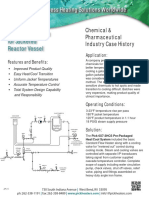Concept Note - Earth Air Tunnel
Concept Note - Earth Air Tunnel
Uploaded by
Lalit JainCopyright:
Available Formats
Concept Note - Earth Air Tunnel
Concept Note - Earth Air Tunnel
Uploaded by
Lalit JainOriginal Description:
Copyright
Available Formats
Share this document
Did you find this document useful?
Is this content inappropriate?
Copyright:
Available Formats
Concept Note - Earth Air Tunnel
Concept Note - Earth Air Tunnel
Uploaded by
Lalit JainCopyright:
Available Formats
EARTH AIR TUNNEL SYSTEMS
Working Principle
Earthair tunnel heat exchanger (EATHE) is one of the passive systems, which utilizes the undisturbed ground
temperature below the earths surface to heat and cool the buildings.
At a depth of 4 metres below the ground, the earth's temperature remains more or less constant throughout the
year. This temperature is nearly equal to average temperature of the place. For example, in Delhi, the summer
temperature may go up to 45C and fall to 4C during winter, but 4m below the ground the temperature remains
at nearly 26 C, which is the local average. An earth air tunnel takes advantage of this phenomenon.
Network of pipes are laid at that depth and are connected to the dwelling. When the hot summer air (sucked in by
some mechanism, such as fans) passes through the pipes, the surrounding soil acts as a heat exchanger and cools
the air which is then routed into the building. The reverse happens during winters. Cold air is sucked in and passes
through the pipes, absorbing earth's heat and releasing it into the housing complex or the dwelling unit.
This technology is called as Earth tubes in Europe, Earth-air heat exchangers in North America, Earth tunneling in
India. They are also known by several other names, including air-to-soil heat exchanger, earth channels, earth
canals, earth-air tunnel systems, ground tube heat exchanger, subsoil heat exchangers, underground air pipes etc.
Types of Earth Air Tunnels
1. Closed loop system: In this system, same air is recirculated in the building. The air from inside the building is
blown through a U-shaped loop of pipes which are 30.0 to 150.0 m (100 to 500 feet) in length. The air is
moderated to near earth temperature before returning to be distributed via ductwork throughout the building.
The closed loop system can be more effective than an open system, since it cools and re cools the same air.
2. Open system: In this system the outside ambient air is drawn from a filtered air intake. The cooling tubes are
typically 30.0 m (100 feet) long straight tubes laid below the ground and then drawn into the building. It is
a process of exchanging the energy contained from outdoor ventilation. During the warmer seasons, the
system pre-cools and dehumidifies, while humidifying and pre-heating in the cooler seasons. This system helps
to improve the indoor air quality while reducing total HVAC equipment capacity. An open system combined
with energy recovery ventilation can be nearly as efficient (80-95%) as a closed loop, and ensures that entering
fresh air is filtered and tempered.
2. Combination system: This is a combination of both the above systems. This can be constructed with dampers
that allow either closed or open operation, depending on fresh air ventilation requirements. Such a design,
even in closed loop mode, could draw a quantity of fresh air when an air pressure drop is created. It is better to
draw in filtered passive cooling tube air than unconditioned outside air.
Important factors for Performance of Earth Air Tunnel
The amount of heat exchanged between the air and the surrounding soil is a function of the parameters like;
surface area of the tunnel walls, length of the tunnel, inlet air temperature, velocity of air in the tunnel, material of
the tunnel, surface conditions of the tunnel walls, and the depth of tunnel from ground surface.
Material
Most systems are usually a network of pipes made of concrete, PVC, steel, rigid or semi-rigid plastic, plastic-coated
metal pipes or plastic pipes coated with inner antimicrobial layers. These pipes are 100 600mm (4 - 24 inches) in
diameter and have a smooth inner surface. The diameter, layout and cleanliness of the piping are critical for the
overall performance of the system. Smaller diameter tubes require more energy to move the air and have less
earth contact surface area. Larger tubes permit a slower airflow, which also yields more efficient energy transfer
and permits much higher volumes to be transferred, permitting more air exchanges in a shorter time period.
Length of the tunnel
The length of the pipe is proportional to the area of the building that has to be air conditioned. The performance of
the system is better with bigger length tunnels vis--vis smaller length tunnels.
Depth of the tunnel
Air temperature, at a depth of about 4.0 to 5.0m (12 - 15 feet), stays fairly constant throughout the year, and is
approximately equal to the average annual ambient air temperature (i.e. it is lower than the ambient temperature
during summers and relatively higher than the ambient air temperature during summers).
The underground ambient earth temperature is typically 10 to 23 C (50 -73F) all year round in the temperate
latitudes where most humans live. Daily and annual temperature fluctuations decrease with the increase in depth
below the ground surface.
Daily temperature variations hardly affect the earth's temperature at a depth of more than one meter, while the
seasonal variations of the ambient temperature are strongly dampened by the earth. The earth's temperature up
to a depth of 6.0 to 8.0 m (18 24 feet) is influenced by the annual ambient temperature variations with a time
delay of several months.
Piping Angle
The piping system should avoid sharp 90-degree angles in the construction. Smooth wall tubes are more efficient
in moving the air, they are less efficient in transferring energy. Two 45-degree bends produce less-turbulent, but
more efficient air flow.
Performance of the system
The systems described above have the potential to give very high coefficients of performance (COP), and therefore
high energy savings. Normally, heating and air conditioning systems have average year-round COPs of about 2.0
However the COPs of the systems utilizing underground air tunnels are much higher. For open and closed loop
systems, the COP can be as high as 10. By doubling the COP over a conventional system, the energy input (energy
that one pays for) is reduced by 30 - 50 percent.
In addition to energy conservation, this technique also increases the capacity of a conventional system.
Merits of Earth Air Tunnel
1. Better indoor air quality
2. 100% fresh air circulation in the premises
3. Cost effective in both up-front and capital costs
4. Reduces long-term operation and maintenance costs
5. Consumes 1/3rd less energy than conventional AC system
6. Minimum temperature can be achieved during peak summer
Demerits Earth Air Tunnel
1. Performance of the system depends on location's latitude, altitude, ambient Earth temperature, climatic
temperature, relative humidity extremes, solar radiation, water table, soil type, soil moisture content and the
efficiency of the building's exterior envelope design.
2. Numerous earth-air heat exchanger systems have been designed and constructed improperly, and failed to
meet design expectations. Earth-air heat exchangers appear best suited for air pretreatment rather than for
full heating or cooling.
3. Dry and low density soil with little or no ground shade will yield the least benefit.
4. Less effective in hot humid climates where the ambient temperature of the earth approaches human comfort
temperature. The higher the ambient temperature of the earth, the less effective they are for cooling and
dehumidification.
5. Payback stretches beyond 4+ years in most cases.
6. The tunnels would be especially useful for large buildings with ample surrounding ground.
7. The EAT system cannot be cost effective for small individual residential buildings.
Other issues observed in Earth Air Tunnel
Condensation inside the tubes, condensation occurs when temperature inside the tubes is lower than the dew
point temperature
Removal of moisture from the cooled air is always an issue and system may have to be used with regular air
conditioner
Water in the tubes also result in growth of mould or mildew
Insects and rodents may enter into the tubes of an open loop system
Case Study: TERI
Earth Air Tunnels have been used successfully at TERI retreat at Gurgaon, Gul Pahari, Delhi, where the
underground tunnels serve the living quarters. Earth air tunnel system is used for free cooling/heating of the
building for a major part of the year. This technology uses the heat sink property of earth to maintain comfortable
temperatures inside the building. Supplementary systems are also used for extreme conditions (monsoon).
Four tunnels of 70 m length and 70cm diameter each laid at a depth of 4 m below the ground to supply
conditioned air to the rooms
At a depth of 4 m below the ground, temperature remains 26C (in Gurgaon) throughout the year.
Four fans of 2hp force the air in and solar chimneys force the air out of the rooms.
Assisted cooling by air washer in dry summer and a 10 TR dehumidifier in monsoons.
In such a system energy savings of nearly 30 - 50% compared to conventional system can be achieved. At the
campus, this system is used for providing comfort for the rooms in hostel block.
The winter temperature in the rooms heated by Solar gains and earth air tunnel systems was about 22C when the
ambient temperature was 10C, whereas in dry summer month of may, room temperature cooled by earth air
tunnels was observed to be 28C with 45% - 50% relative humidity, when the ambient temperature and relative
humidity were 40C and 50% respectively.
The living quarters are maintained at temperatures approximately between 20 to 30C round the year. The system
utilizes tunnel, air intake ports and dehumidification. The treated air is passed to the spaced through ducts and
supply grills and are allowed to escape to the atmosphere after affecting the desired heat transfer in the space.
You might also like
- BIM Technical Standards - MEP Color Mapping - GSADocument2 pagesBIM Technical Standards - MEP Color Mapping - GSANagarjuna Reddy M0% (1)
- TadIran TAC600Document98 pagesTadIran TAC600Eric Korshie Dzokoto100% (3)
- Specialized Air Conditioning SystemDocument6 pagesSpecialized Air Conditioning SystemSACHIDANANDA SNo ratings yet
- 588-Water Cooler Cum HeaterDocument6 pages588-Water Cooler Cum Heatersanu222100% (3)
- Buildings - 100 - 19 - Infosys - Limited - Pune - 0Document31 pagesBuildings - 100 - 19 - Infosys - Limited - Pune - 0Sunidhi VermaNo ratings yet
- Vernacular Mud Construction Techniques of Vidarbha RegionDocument6 pagesVernacular Mud Construction Techniques of Vidarbha RegionShaikh Mohsin100% (1)
- Medieval India: Orchcha and Datia Fatehpur Sikri ManduDocument62 pagesMedieval India: Orchcha and Datia Fatehpur Sikri ManduSourish ChoudhuryNo ratings yet
- Architectural Case Study 1, Nit TrichyDocument6 pagesArchitectural Case Study 1, Nit TrichyRaghavi SathyaNo ratings yet
- Define Types of Bioclimatic Charts. Explain The Applicability and Limitation of Bioclimatic Charts.Document4 pagesDefine Types of Bioclimatic Charts. Explain The Applicability and Limitation of Bioclimatic Charts.Pooja SharmaNo ratings yet
- Exploring Feasibility of Passive Cooling Techniques in Residential Buildings in KeralaDocument7 pagesExploring Feasibility of Passive Cooling Techniques in Residential Buildings in KeralaEsther AbraahamNo ratings yet
- NYATIDocument7 pagesNYATIshweta kakadeNo ratings yet
- PR0030Document5 pagesPR0030MISHTIGALNo ratings yet
- University of Jodhpur CampusDocument4 pagesUniversity of Jodhpur CampusnidhiNo ratings yet
- Butwal Power Company Limited (BPC) Office BuildingDocument13 pagesButwal Power Company Limited (BPC) Office BuildingSagar MahatNo ratings yet
- Climatology-Unit III 3rd SEMDocument14 pagesClimatology-Unit III 3rd SEMflower lilyNo ratings yet
- Infosys Campus: ProjectDocument19 pagesInfosys Campus: ProjectSharvani MedaNo ratings yet
- Manjunath, Neelam PDFDocument17 pagesManjunath, Neelam PDFSaumya ShuklaNo ratings yet
- Sem 8TH Site PlanningDocument23 pagesSem 8TH Site PlanningmujjuNo ratings yet
- Center, Noida: Patni (i-GATE) KnowledgeDocument1 pageCenter, Noida: Patni (i-GATE) KnowledgeMuskaan RampalNo ratings yet
- MR Guruprakash Sastry - InfosysDocument6 pagesMR Guruprakash Sastry - Infosyssahil mouryaNo ratings yet
- Single and Double Loaded CorridorDocument21 pagesSingle and Double Loaded CorridorMohammad EhsanNo ratings yet
- Audi Case StudyDocument8 pagesAudi Case Studydhanaraj100% (1)
- The Newtown School NewDocument11 pagesThe Newtown School NewmaneetNo ratings yet
- ProjectDocument16 pagesProjectAkshay HalyalNo ratings yet
- Case Study Hvac Assignment 1Document11 pagesCase Study Hvac Assignment 1Manjeet CinghNo ratings yet
- Site Analysis: Gurugram Sec-31Document16 pagesSite Analysis: Gurugram Sec-31AditiNo ratings yet
- Matka Chowk - Traffic and Transportation - Sana Sawhney and Siddharth MahajanDocument5 pagesMatka Chowk - Traffic and Transportation - Sana Sawhney and Siddharth MahajanSana SawhneyNo ratings yet
- Charles CorreaDocument99 pagesCharles CorreaaadyaagrawalNo ratings yet
- Unit 2 Forms of Human SettlementDocument20 pagesUnit 2 Forms of Human SettlementSINDHU KUMARESANNo ratings yet
- Green DesignDocument44 pagesGreen DesignAshru SigdelNo ratings yet
- Newari House 161510121413Document18 pagesNewari House 161510121413stojshakyasNo ratings yet
- Yamuna Apartments Case StudyDocument1 pageYamuna Apartments Case StudyanjalijadhavNo ratings yet
- Gesundheit Institute: Case Study - InferenceDocument1 pageGesundheit Institute: Case Study - InferenceIndraja RmNo ratings yet
- Anathandavapuram ReportDocument15 pagesAnathandavapuram Reportpriyasankar7100% (1)
- Smart Cum Luxury Group Housing: Sunderdeep College of Architecture Nh-24, Dasna, GhaziabadDocument71 pagesSmart Cum Luxury Group Housing: Sunderdeep College of Architecture Nh-24, Dasna, GhaziabadPrajapati Ankit100% (1)
- Birla Global University 2. Pearl Fashion Academy 3. Brick School of ArchitectureDocument50 pagesBirla Global University 2. Pearl Fashion Academy 3. Brick School of ArchitectureAman singhNo ratings yet
- Hampi Settlement Study 20k20-21Document12 pagesHampi Settlement Study 20k20-21Sporty GameNo ratings yet
- Ole Scheeren: Why Great Architecture Should Tell A StoryDocument34 pagesOle Scheeren: Why Great Architecture Should Tell A StorySoma Sanubari100% (1)
- Case Study NasariaDocument20 pagesCase Study NasariaHarsh SinhaNo ratings yet
- Site Planning-Indira Paryavarn BhwanDocument7 pagesSite Planning-Indira Paryavarn BhwanAnjali RaithathaNo ratings yet
- Paolo SoleriDocument13 pagesPaolo SoleriNandha Kumar GurusamyNo ratings yet
- Climate Warm and HumidDocument15 pagesClimate Warm and HumidUzma MekraniNo ratings yet
- Sukirthi K 19rbar064 Building Services Assignment - 1Document24 pagesSukirthi K 19rbar064 Building Services Assignment - 1SUKIRTHI K 19RBAR064No ratings yet
- ARCUATED Literature Study and Site Study PDFDocument68 pagesARCUATED Literature Study and Site Study PDFAnika SethiNo ratings yet
- ESF Pandharpur CSDocument31 pagesESF Pandharpur CShiyogsNo ratings yet
- Day Street Apartment Literature StudyDocument18 pagesDay Street Apartment Literature StudyprasannaNo ratings yet
- Warm and Humid GREEN BUILDING CASE STUDYDocument8 pagesWarm and Humid GREEN BUILDING CASE STUDYPooja PrakashNo ratings yet
- AtriumDocument8 pagesAtriumZakki GhaniNo ratings yet
- Group B3 - Long Span BeamDocument6 pagesGroup B3 - Long Span BeamAmey DeshmukhNo ratings yet
- AdvantagesDocument3 pagesAdvantagesSanjana BhandiwadNo ratings yet
- Presentation ON Ar. Romi Khosla: Presented By: Harshita RanaDocument18 pagesPresentation ON Ar. Romi Khosla: Presented By: Harshita RanaHarshita RanaNo ratings yet
- Desktop Case StudyDocument6 pagesDesktop Case StudyAishwaryaNo ratings yet
- 55 Window PalaceDocument9 pages55 Window PalaceBinisha RautNo ratings yet
- Indira Gandhi Stadium ComplexDocument2 pagesIndira Gandhi Stadium ComplexRájDèép TrìpâţhíNo ratings yet
- THESIS Synopsysis NET ZERO ENERGY BUILDING AND HOTELDocument4 pagesTHESIS Synopsysis NET ZERO ENERGY BUILDING AND HOTELKranthikumar PrathiNo ratings yet
- Indira Paryavaran Bhawan Jor Bagh, New Delhi: By-Anchal Angad Karuna Megha Sunil SravantiDocument26 pagesIndira Paryavaran Bhawan Jor Bagh, New Delhi: By-Anchal Angad Karuna Megha Sunil SravantiDhruvNo ratings yet
- The Design VillageDocument10 pagesThe Design VillageJanmanta GoswamiNo ratings yet
- Unit 4 - Contemporary Examples Adopting Traditional Architectural Elements in RajasthanDocument39 pagesUnit 4 - Contemporary Examples Adopting Traditional Architectural Elements in RajasthanJeewanshu UttamNo ratings yet
- Ad Case Study Sem6Document18 pagesAd Case Study Sem6sakshi meherNo ratings yet
- IITJ - CMP - Presentation - 29 10 2014 12 02 49 PDFDocument41 pagesIITJ - CMP - Presentation - 29 10 2014 12 02 49 PDFITISHA JAINNo ratings yet
- Structural Controls For Climate Responsive Design (For Cooling Purpose)Document31 pagesStructural Controls For Climate Responsive Design (For Cooling Purpose)mehtabhumikaaNo ratings yet
- Tamil Quarters PondicherryDocument6 pagesTamil Quarters PondicherryAkash MvNo ratings yet
- Use of Underground Air Tunnels For Heating and Cooling Agricultural and Residential BuildingsDocument4 pagesUse of Underground Air Tunnels For Heating and Cooling Agricultural and Residential Buildingskhannamoney123No ratings yet
- TRANE - FCU SelectionsDocument16 pagesTRANE - FCU SelectionshanamanNo ratings yet
- Ventilation in Hospital ProjectsDocument18 pagesVentilation in Hospital ProjectsMAGDY KAMELNo ratings yet
- Top 250+ HVAC Interview Questions - Best HVAC Interview Questions and Answers - Wisdom JobsDocument11 pagesTop 250+ HVAC Interview Questions - Best HVAC Interview Questions and Answers - Wisdom Jobsprabhanshu241991No ratings yet
- Drawing Register & Transmittal Drawing Register & Transmittal Drawing Register & Transmittal Drawing Register & TransmittalDocument13 pagesDrawing Register & Transmittal Drawing Register & Transmittal Drawing Register & Transmittal Drawing Register & Transmittalsachin231979No ratings yet
- Greenheck Fan - Selection - GuideDocument4 pagesGreenheck Fan - Selection - GuideMurray PeartNo ratings yet
- Plant - Room.Position - And.Size: DistributionDocument26 pagesPlant - Room.Position - And.Size: DistributionMhr IzadNo ratings yet
- Ishrae PPT On RefrigerantDocument9 pagesIshrae PPT On RefrigerantJigar ShahNo ratings yet
- User Manual For Greenstar Si CompactDocument24 pagesUser Manual For Greenstar Si CompactpoiuNo ratings yet
- Radiateur Cat 320c - Sisweb - Servlet - Cat - Cis.sis - PController.CSSISCDocument3 pagesRadiateur Cat 320c - Sisweb - Servlet - Cat - Cis.sis - PController.CSSISCMehdi ChakrouneNo ratings yet
- A Technical Reference Manual For Plate Heat Exchangers in Refrigeration & Air Conditioning ApplicationsDocument176 pagesA Technical Reference Manual For Plate Heat Exchangers in Refrigeration & Air Conditioning Applicationsmdalt9180No ratings yet
- 51KWF/51EWF: comfort technology ةيلاثملا ةــحارلاDocument1 page51KWF/51EWF: comfort technology ةيلاثملا ةــحارلاYousefNo ratings yet
- VIP 32 Hybrid VentDocument8 pagesVIP 32 Hybrid VentsagarNo ratings yet
- DBR-HVAC Rev 0Document16 pagesDBR-HVAC Rev 0psjjoshiNo ratings yet
- Performance Test of AIR CONDITIONING SYSTEMDocument20 pagesPerformance Test of AIR CONDITIONING SYSTEMZa YonNo ratings yet
- BITZER Output Data: Created On: 16/05/2017 16:44:22Document5 pagesBITZER Output Data: Created On: 16/05/2017 16:44:22Hasan Syaiful INo ratings yet
- HVAC System Load CalculationDocument7 pagesHVAC System Load CalculationMohammed MujahedNo ratings yet
- 2014 Modern Hydronic System Designs Hts AshraeDocument41 pages2014 Modern Hydronic System Designs Hts AshraeNagarjun ReddyNo ratings yet
- Cooling System Basic PrinciplesDocument2 pagesCooling System Basic PrinciplesBryan MartinezNo ratings yet
- RAC April May 2010 To 2012Document11 pagesRAC April May 2010 To 2012Shashi Bhushan PatelNo ratings yet
- Diagrama de Intercambiador de CalorDocument3 pagesDiagrama de Intercambiador de CalorVictor Uriona BelloNo ratings yet
- HVAC Interview Questions - Interview Q & A - Industrial Automation, PLC Programming, Scada & Pid Control System PDFDocument1 pageHVAC Interview Questions - Interview Q & A - Industrial Automation, PLC Programming, Scada & Pid Control System PDFprabhanshu241991No ratings yet
- Air/water Heat Pump F2040: UHB EN 1826-5 231845 User ManualDocument28 pagesAir/water Heat Pump F2040: UHB EN 1826-5 231845 User ManualIacome DanNo ratings yet
- Business Directory Machinery - Refrigeration, Air Conditioning, Cooling Equipment, Heat Exchangers Machinery & Equipment (Page 1 of 6) - NPCSDocument14 pagesBusiness Directory Machinery - Refrigeration, Air Conditioning, Cooling Equipment, Heat Exchangers Machinery & Equipment (Page 1 of 6) - NPCSViraj ShiroleNo ratings yet
- Avs26 2 Completa PDFDocument44 pagesAvs26 2 Completa PDFWagner CarvalhoNo ratings yet
- CalorifierDocument30 pagesCalorifierlusifadilahNo ratings yet
- Downloaded From Manuals Search EngineDocument42 pagesDownloaded From Manuals Search Enginecesar luis gonzalez rodriguezNo ratings yet
- Jacketed Reactor Vessel PDFDocument1 pageJacketed Reactor Vessel PDFSH1961No ratings yet

























































































